Maritime history of Europe: Difference between revisions
m gen fixes and/or cite template fixes using AWB |
|||
| Line 101: | Line 101: | ||
*[[Maritime history]] |
*[[Maritime history]] |
||
*[[Naval warfare]] |
*[[Naval warfare]] |
||
I don't think the Naval warfare and the Maritime history is very helpful, just look at the HISTORY OF EUROPE!!! |
|||
==External links== |
==External links== |
||
Revision as of 23:11, 18 September 2008
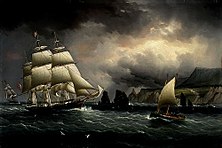
Maritime history of Europe is a term used to describe significant past events relating to the northwestern region of Eurasia in areas concerning shipping and shipbuilding, shipwrecks, naval battles, and military installations and lighthouses constructed to protect or aid navigation and the development of Europe. Although Europe is the world's second-smallest continent in terms of area, is has a very long coastline, and has arguably been influenced more by its maritime history than any other continent.
Europe is uniquely situated between several navigable seas and intersected by navigable rivers running into them in a way which greatly facilitated the influence of maritime traffic and commerce. Great battles have been fought in the seas off of Europe that changed the course of history forever, including the Battle of Salamis in the Mediterranean, the Battle of Gravelines at the eastern end of the English Channel in the summer of 1588, in which the “Invincible” Spanish Armada was defeated, the Battle of Jutland in World War I, and World War II’s U-boat war.
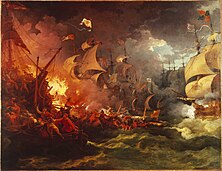
Ancient times

Although the Egyptians built the first sea-going ships, the Minoans of Crete were the first great seafarers of the Mediterranean Sea. Little is known of their ships, but they reportedly traded pottery as far west as Sicily, and their King Minos conquered the islands of the Aegean (according to Thucydides).
The Battle of Salamis occurred in September 480 BC, when the Greeks, with 371 triremes and ‘’pentekonters’’, routed a Persian force of over 1,200 ships under the command of King Xerxes. Persian losses amounted to some 200 ships and 20,000 men. The battle was fought near Athens, Greece, in the straits between Piraeus and Salamis.
Maritime history of the Roman Empire
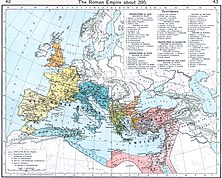
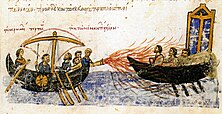
Roman galleys helped to build the Roman Empire. The empires’ struggle with Carthage inspired them to build and to fight in war galleys, but the galleys did not have much cargo space, so “round ships” were constructed for trade, especially with Egypt. Many of these ships reached 200 feet (61 m) in length and were capable of carrying over a thousand tons of cargo. These ships used sail power alone to haul commodities in the mediterranean sea. The volume of trade that the roman merchant fleet carried was larger that any other until the industrial revolution. We know quite a bit about these round ships, since Romans, like Egyptians and Greeks, left records in stone, sometimes even on a sarcophagus.
There were many shipwrecks of Roman vessels, this fact can be explained for two reasons:
- Their operators did not seem to have learned about the lateen rig or the fore-and-aft, which would have made the ships more manageable and reduced wrecking incidents.
- There were a very large number of trading vessels during Roman times since the volume of sea trade in the mediterranean reached a quantity to be only equaled in the 19th century. This greatly increased the number of shipwrecks.
The western Mediterranean came under the control of the barbarians, after their invasion split the Empire in two, while Byzantium dominated the eastern half of the sea. The eastern empire lasted until 1453, such was the efficiency of the Byzantine navy, with its fleets armed with Byzantine fire (or Greek fire), a mixture of naphtha oil and saltpetre, fired through tubes in the bows of the ship. Enemy ships were often afraid to get too close to the Byzantine fleet, since the liquid fire gave the Byzantines a considerable advantage.
The Viking Age

“From the fury of the Norsemen, good Lord deliver us,”' was a common prayer among the people of western Europe during the period of the Norse raiders from the late 8th century to the 11th century. Also called the Vikings, the Norsemen raided towns and villages along the coasts of the British Isles, Scandinavia, as far south as Cádiz, Spain and even attacked Pisa, Italy in 860. They sailed up the Seine River in France, settled Normandy (which derives its name from the Norsemen), and settled Dublin after invading Ireland.
The Vikings were the best naval architects of their day, and the Viking longship was one of the most functional warships ever built. A longship found at Oseberg, Norway, was 76 feet (23 m), 6 inches in length (more than 23 meters), more than 17 feet (5.2 m) wide, and had a draft of only 3 feet (0.91 m). The shallow draft enabled them to navigate far inland in shallow rivers. Later on during the Viking period some of the ships were reported to be over 100 feet (30 m) long. Swedish Vikings, called "Varangians", were more concerned with trading than raiding, and sailed along Russian rivers and opened commercial routes to the Caspian Sea as well as the Black Sea.
The Hanseatic League

The Hanseatic League was an alliance of trading cities that established and maintained a trade monopoly over the Baltic Sea and most of Northern Europe for a time in the later Middle Ages and the Early Modern period, between the 13th and 17th centuries. Although trading alliances in the region were forming as early as 1157, the town of Lübeck did not form an alliance with Hamburg (which controlled access to salt routes from Lüneburg), until 1241.
Trade was carried on chiefly by sea in order to escape tolls and political barriers, and at the end of the fifteenth century the Hanseatic League controlled some 60,000 tons of shipping. Although compasses were commonly being used in the Mediterranean during this period, the captains of Hanseatic vessels seemed slow to adopt the new technology, which put them in greater danger of wrecking. They also had to deal with pirates.
The League’s power waned when the great herring shoals disappeared in the Baltic, possibly because of a decline in the sea’s salinity. During the late 16th century and early 17th century, the League fell apart, as it was unable to deal with its own internal struggles, the rise of Swedish, Dutch and English merchants, and the social and political changes that accompanied the Reformation. Although a tight-fisted monopoly, the League’s need for more cargo space led to new designs in shipbuilding, and its free association of about 160 towns and villages was a historically unique economic alliance that showed the benefits of well-regulated commerce.
Republic of Venice
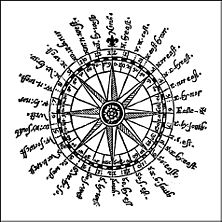

Around 1300, Venice began to develop the great galley of commerce, the ‘’galea grossa’’. It grew to carry a crew of more than 200 and weighed as much as 250 tons. These galleys took passengers and goods to Constantinople (now Istanbul), and to Alexandria in Egypt, and returned to Venice carrying luxury items. A sea route to the Indies discovered by Portugal signaled an end to the glory days of Venice's merchant galleys and spice trade, but the war galleys (or fighting galleys) lived on. The war galleys were mostly manned by prisoners of war or convicts, who were chained to benches, usually three to six per oar.
More than 3,000 Venetian merchant ships were in operation by the year 1450. The trading empire of the Republic of Venice lasted longer than any other in history, and even merchants vessels were required to carry weapons and passengers were expected to be armed and ready to fight. From the beginning of the 1200s until the end of the 1700s, the Republic ruled the Adriatic, the Aegean and the Black Seas. The Republic of Genoa was Venice’s main rival, and many wars were fought between them. In 1298 the Genoese destroyed the Venetian fleet at Curzola, but were themselves defeated in 1354 at Sapienza in Greece.
The European Age Of Discovery 1400 - 1600
The Age of Discovery started with the Portuguese navigators. Prince Henry the Navigator would start a maritime school in Portugal. The resulting technical and scientific discoveries led to Portugal developing the most advanced ships / caravals that for the first time in history would make truly global maritime naigation possible. It led to the Portuguese Kingdom discovering and mapping most of the Globe. The route to India via the Cape of Good Hope was discovered in two phases. Initially Bartholemeu Dias left Portugal and rounded the Cape of Good Hope. The Second phase would take Vasco da Gama around the southern tip of Africa and on to India and the East. It was the first time in history that humans had navigated from Europe around Africa to Asia. It also led to the discovery of Brazil and South America. It would also be a Portuguese nobleman, Ferdinand Magellan (although at the time lending his services to the Spanish crown) that would be the first man to sail around the world.
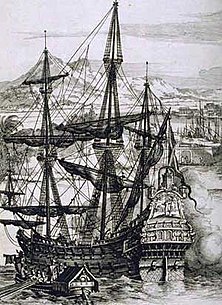
Christopher Columbus set sail in the Santa Maria on what is probably history’s greatest voyage of discovery on August 3, 1492. Leaving from the town of Palos, in southern Spain, Columbus headed west. After a brief stop in the Canary Islands for provisions and repairs, he set out for Asia. He reached San Salvador first, it is believed, (easternmost of the Bahamas) in October, and then sailed past Cuba and Hispaniola, still searching for Asia. He returned home in 1493 to a hero's welcome, and within six months had 1,500 men and 17 vessels at his command.
The year 1571 saw the last great battle between galleys, when more than 400 Turkish and Christian vessels engaged each other on the Gulf of Patras. The Battle of Lepanto as it was called, saw some 38,000 men perish. Miguel de Cervantes, author of Don Quixote, was wounded during the battle. In April 1587, Sir Francis Drake burned 37 Spanish ships in the harbor at Cádiz, in southern Spain.
The publication of Jan Huygen van Linschoten's book Voyages provided a significant turning point in Europe's maritime history. Before the publication of this book, knowledge of the sea route to the Far East had been well guarded by the Portuguese for over a century. Voyages was published in several languages, including English and German (published in 1598), Latin (1599), and French (1610). Widely read by Europeans, the original Dutch edition and the French translation had second editions published.
Once knowledge of the sea route became available to all Europeans, more ships headed to East Asia. A Dutch fleet embarked on a voyage to India using Linschoten’s charts in 1595. (The Dutch version of his book was published in 1596, but his sea charts had been published the previous year). The publication of the nautical maps enabled the Dutch and British East India companies to break the trade monopoly Portugal held with the East Indies. Protestant Europe was ushered into the age of discovery in large part thanks to his work.
European innovations

From the sixth to the eighteenth centuries, the maritime history of Europe had a profound impact on the rest of the world. The broadside-cannoned full-rigged sixteenth-century sailing ship provided the continent with a weapon to dominate the world.

During this time period, Europeans made remarkable inroads in maritime innovations. These innovations enabled them to expand overseas and set up colonies, most notably during the sixteenth and seventeenth centuries. They developed new sail arrangements for ships, skeleton-based shipbuilding, the Western “galea” (at the end of the eleventh century), sophisticated navigational instruments, and detailed charts. After Isaac Newton published the Principia, navigation was transformed. Starting in 1670, the entire world was measured using essentially modern latitude instruments and the best available clocks. In 1730 the sextant was invented and navigators rapidly replaced their astrolabes.
Barbary pirates
For several centuries, from about the time of the Crusades until the early 1800s, the Barbary pirates of northern Africa preyed on ships in the western Mediterranean Sea. In 1816, the Royal Navy, with assistance from the Dutch, destroyed the Barbary fleet in the port of Algiers. The best-known pirate of this period may have been Barbarossa, the nickname of Khair ad Din, an Ottoman-Turkish admiral and privateer who was born on the island of Lesbos, (present-day Greece), and lived from about 1475-1546.
Siege of Gibraltar and the Battle of Trafalgar

July of 1779 saw the start of the Great Siege of Gibraltar, an attempt by France and Spain to wrest control of Gibraltar from the British. The garrison survived all attacks, including an assault on September 13, 1782 that included 48 ships and 450 cannon. In October 1805, the Battle of Trafalgar took place, which involved 60 vessels, 27 British, and 33 French and Spanish. The British did not lose a single ship, and destroyed the enemy fleet, but Admiral Lord Nelson died in the battle. It was the most significant naval battle of the beginning of the nineteenth century, and confirmed the British Navy’s supremacy of the time.
Lighthouses
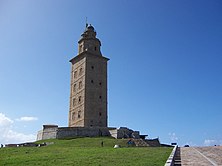
The Pharos of Meloria is often considered the first lighthouse in Europe since Roman times. Meloria, a rocky islet off the Tuscan coast in the Tyrrhenian Sea, was the location of two medieval naval battles. The Tower of Hercules (Torre de Hércules), in northwestern Spain, is almost 1,900 years old. The ancient Roman lighthouse stands near A Coruña, Galicia, and is 57 metres (185 ft) in height. It is the oldest working Roman lighthouse in the world.
According to Smithsonian, a lighthouse on the Gironde River in France, Cardovan Tower, was the first lighthouse to use a Fresnel lens in 1822. The light reportedly could be seen from more than 20 miles (32 km) at sea.
Oil spills
There have been several large oil spills off the coasts of Europe since 1967. They include (in order from largest to smallest):
- Amoco Cadiz (BP/Amoco, USA) Brittany, France, March 16, 1978
- Torrey Canyon, South England, March 18, 1967
- Urquiola, A Coruña, Spain, May 12, 1976
- Othello, Tralhavet Bay, Sweden, March 20, 1970
- Braer - Shetland Islands, January 5, 1993
- Prestige - Galicia, Spain, November 13, 2002
- Aegean Sea, A Coruña, Spain, December 3, 1992
See also
I don't think the Naval warfare and the Maritime history is very helpful, just look at the HISTORY OF EUROPE!!!
External links
- National Maritime Museum, London - [1]
- Early Maritime Maps Online
References
- A Study of 16th Century Western Books on Korea: The Birth of an Image, Myongji University
- Pryor, John, Maritime History, University of Sydney, course outline
- Villiers, Alan, Men Ships and the Sea, National Geographic Society, 1962, pgs. 62, 70, 132 & 133
